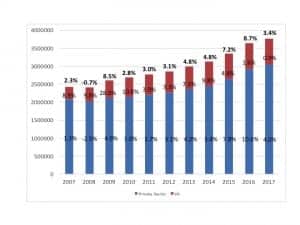Staff Standpoint | February 2018 Hearing Review

Hearing aid unit sales, 2007-2017. Percentages represent year-on-year increases/decreases in net units for the entire market (top bold), the VA (red), and the private/commercial sector (blue). Source: HIA.
Hearing aid net unit sales in the United States grew by 3.4% in 2017, with a 4.0% growth rate for the commercial/private sector and 0.92% for the Department of Veterans Affairs (VA), according to statistics generated by the Hearing Industries Assn (HIA), Washington, DC. As shown in Figure 1, a total of 3.77 million hearing aids were dispensed in 2017. The 3.4% gain in 2017 was modest in comparison to the two previous years (7.2% and 8.7% in 2015 and 2016, respectively), and more in line with the industry’s historical norm of a 2-4% annual growth rate. The VA made up 19.3% of the US market.
Sales growth was particularly strong during the fourth quarter of 2017, with a 6.0% increase over the same period last year—powered by a 7.3% increase in unit sales for the private sector. The VA saw its units increase by 0.9% in Q4.
Because private-sector sales also encompass mass merchandisers like Costco—and hearing aid sales’ statistics are unavailable for these retailers—it has become increasingly difficult to guess how the “average” private-practice dispensing office fared during the year. If Costco continued at the 8% growth rate Hearing Review estimated for 2016, that would mean mass retailers probably account for about 12% or more of all hearing aids dispensed, and the average dispensing practice saw actual unit gains of around 3.4% in 2017. Again, it should be emphasized that these are “guesses” by the editor. Additionally, it should also be noted that the average selling prices (ASPs) of hearing aids have been declining on average by 1-2% annually (or more), so gross revenues for many businesses may have been relatively flat.
According to the HIA statistics, a total of 82.8% of all hearing aids dispensed in 2017 were behind-the-ear (BTE) style devices, and over two-thirds (69.4%) were of the receiver-in-the-canal (RIC) or receiver-in-the-ear (RITE) style (subclasses of BTEs). Traditional BTEs constituted 13.4% of all hearing aids sold. In-the-ear (ITE) hearing aids made up less than one-fifth (17.2%) of the entire market in 2017. In-the-canal (ITC) type aids constituted 5.8% of all the units sold, full-shell ITEs (4.9%), and half-shell ITEs (1.5%) made up a similar proportion, while CICs accounted for 4.4% of all hearing aids sold, according to HIA.
Citation for this article: Strom KE. Hearing aid sales increase by 3.4% in 2017. Hearing Review. 2018;25(2):6.





